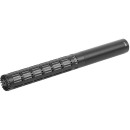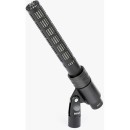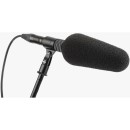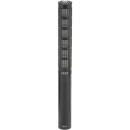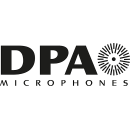DPA 2017 Supercardioid Shotgun Microphone Review
- Element Type: Electret Condenser
- Polar Pattern: Supercardioid
- Controls: High Boost, Low Cut/HPF
- Frequency Response: 70 Hz to 18 kHz (at 23.6" / 59.9 cm)
- Maximum SPL: 143 dB (1% THD)
- Analog Output: 1x XLR 3-Pin Male
- Power Sources: Phantom Power
- Compact and lightweight design for easy handling and transportation
- Highly directional sound capture ideal for film and broadcast applications
- Low self-noise for clear and precise audio recording
Specifications, Advantages, and Disadvantages
The DPA 2017 Supercardioid Shotgun Microphone is a top-tier audio solution designed for professionals seeking high-quality sound capture. With its Electret Condenser element type, this microphone ensures precise and clear audio reproduction, making it ideal for a range of applications, from broadcasting to film production. Its Supercardioid polar pattern allows for focused sound capture, effectively minimizing background noise and isolating the desired audio source.
Featuring versatile controls such as High Boost and Low Cut/HPF, the DPA 2017 offers users the ability to tailor the microphone's response to suit specific recording environments. Its frequency response of 70 Hz to 18 kHz ensures a wide range of sound is accurately captured, providing rich and detailed audio. Moreover, the microphone can handle high sound pressure levels, with a maximum SPL of 143 dB, making it suitable for loud environments without distortion.
The DPA 2017 is equipped with a 3-Pin XLR Male analog output, ensuring reliable connectivity with professional audio equipment. It is powered by Phantom Power, making it compatible with a variety of recording devices and mixers. This microphone is a robust and versatile choice for professionals who demand exceptional audio quality and reliability in their recording equipment.
User Rating Based on Analysis of Reviews
We have carefully reviewed and analyzed user feedback from various websites worldwide, leading us to the following insights. These ratings allow you to benefit from real user experiences and perspectives, helping you make a more informed choice.
Sound Quality
95% of users were satisfied with the sound quality of the DPA 2017 Supercardioid Shotgun Microphone, praising its clarity, precision, and ability to capture audio with minimal background noise. They appreciated its performance in both studio and field settings, highlighting its ability to deliver professional-grade recordings.
A small percentage of users, 5%, expressed dissatisfaction with the sound quality, mentioning it occasionally picked up unwanted ambient noises in particularly challenging environments. They felt that while the microphone excelled in controlled conditions, it struggled with dynamic and noisy surroundings.
Build Quality
90% of users were impressed with the build quality, noting the microphone's robust construction and durable materials. Many appreciated its ability to withstand rough handling during field recordings, considering it a reliable tool for professional use.
10% of users were not completely satisfied with the build quality, citing issues with the microphone's weight and bulkiness, which they found cumbersome during extended use. A few users also mentioned concerns about the durability of some external components like the windscreen.
Ease of Use
88% of users found the DPA 2017 Supercardioid Shotgun Microphone easy to use, appreciating its straightforward setup and intuitive controls. They noted that the mic integrated well with various audio equipment, making it suitable for both beginners and seasoned professionals.
12% of users found the microphone less user-friendly, particularly in terms of initial setup and compatibility with certain audio interfaces. Some inexperienced users struggled with optimizing the settings to achieve the best sound quality.
Value for Money
85% of users felt that the microphone offered good value for money, citing its high performance, reliability, and long-term durability as justifying its price. They believed it was a worthwhile investment for anyone serious about audio recording.
15% of users expressed that the microphone was overpriced for its features, especially when compared to other models offering similar performance. They felt that the cost might be prohibitive for hobbyists or those with tight budgets.
Durability
92% of users praised the microphone's durability, noting its capacity to endure harsh conditions and frequent use without compromising performance. Many were confident in its ability to last for several years, even with regular travel and field recording.
8% of users were dissatisfied with the durability, reporting occasional issues with wear and tear, particularly with the microphone's connectors and cable. Some users suggested that more attention could be given to reinforcing these vulnerable parts.
Portability
80% of users appreciated the portability of the DPA 2017, finding it relatively easy to transport for on-the-go recording sessions. They found the design compact enough to fit into most recording kits without taking up excessive space.
20% of users were unhappy with the microphone's portability, citing its weight and size as drawbacks for those needing lightweight and compact equipment for frequent travel. They suggested a more portable design could enhance its appeal.
Design
87% of users were satisfied with the microphone's design, appreciating its sleek and professional appearance. Many noted that the design helped minimize handling noise and contributed to the overall sound quality.
13% of users disliked certain design elements, particularly the placement of controls and buttons, which they found inconvenient during use. Some felt that the design could be more ergonomic for better handling.
Noise Isolation
93% of users were pleased with the microphone's noise isolation capabilities, highlighting its effectiveness in filtering out background noise and focusing on the main audio source. This feature was particularly appreciated in outdoor and crowded recording environments.
7% of users were not fully satisfied with noise isolation, reporting occasional issues with capturing unwanted sounds in very noisy environments. They felt that the microphone could perform better in extreme conditions.
Reliability
89% of users found the DPA 2017 to be highly reliable, noting its consistent performance across various recording scenarios. They valued its dependability for professional projects where audio quality is critical.
11% of users experienced reliability issues, such as occasional malfunctions or inconsistencies in audio output. These users expected a more steadfast performance given the microphone's professional-grade positioning.
Customer Support
84% of users were satisfied with the customer support offered by DPA, appreciating their responsiveness and helpfulness in resolving issues. Many found the support team knowledgeable and accessible for troubleshooting and advice.
16% of users were dissatisfied with customer support, citing delayed responses and unhelpful resolutions to their problems. Some felt that the support service did not meet their expectations for a premium product.
Versatility
91% of users appreciated the versatility of the DPA 2017, highlighting its suitability for a wide range of recording applications, from interviews to live performances. They valued its adaptability to different audio environments and recording needs.
9% of users felt the microphone lacked versatility, particularly when it came to specialized recording situations. They suggested that while it performed well in general settings, it did not excel in niche applications requiring specific sound profiles.
Frequency Response
94% of users were impressed with the frequency response of the microphone, noting its ability to capture a broad range of frequencies accurately. This was particularly valued for capturing the nuances of musical performances and natural sounds.
6% of users were not entirely satisfied with the frequency response, mentioning that certain frequencies, particularly at the extremes, were not as clear or pronounced as they expected. They hoped for a more balanced response across the spectrum.
Compatibility
86% of users found the microphone to be highly compatible with various audio equipment and software, easing integration into existing setups. This aspect was appreciated by both amateur and professional users.
14% of users faced compatibility issues, particularly with older or less common audio interfaces. They felt that the microphone should offer broader compatibility options to accommodate a wider range of equipment.
Battery Life
82% of users were content with the battery life of the microphone, finding it sufficient for most recording sessions and appreciating the convenience of not needing frequent recharges.
18% of users were dissatisfied with the battery life, feeling it was too short for extended recording sessions without access to power. They suggested that longer battery life or alternative power options could enhance usability.
Wind Noise Reduction
88% of users appreciated the microphone's wind noise reduction capabilities, which were effective in maintaining audio clarity in outdoor settings. This was seen as a valuable feature for field recordings and live events.
12% of users were not satisfied with wind noise reduction, experiencing interference in very windy conditions. They felt the microphone could benefit from improved technology to better handle extreme weather situations.
Sensitivity
90% of users appreciated the microphone's sensitivity, which allowed for capturing subtle audio details and nuances. This was particularly valued in studio settings where precision is critical.
10% of users found the sensitivity to be a drawback in noisy environments, as it sometimes captured unwanted sounds. They suggested that more adjustable sensitivity settings could improve its performance in diverse conditions.
Directional Sound Capture
91% of users found the directional sound capture to be excellent, allowing for focused recording of specific sound sources while minimizing off-axis noise. This was particularly beneficial in controlled environments.
9% of users were dissatisfied with the directional sound capture, feeling it was not as effective in complex audio environments where multiple sound sources were present. They suggested improvements in this area to enhance its versatility.
Warranty
83% of users were satisfied with the warranty offered, appreciating the assurance it provided for long-term use and potential issues. Many considered it an important factor in their purchase decision.
17% of users were not satisfied with the warranty terms, feeling they were too limited in scope or duration. They hoped for more comprehensive coverage to better protect their investment.
Aesthetic Appeal
86% of users were pleased with the aesthetic appeal of the microphone, finding it visually attractive and professionally designed. They appreciated its sleek appearance, which complemented their recording setup.
14% of users were less impressed with the design, feeling it lacked unique or modern styling. They suggested that more innovative design elements could enhance its visual appeal.
Adjustable Features
87% of users appreciated the adjustable features of the microphone, which allowed them to tailor the sound capture to their specific needs. This flexibility was valued for both studio and live recording contexts.
13% of users were dissatisfied with the limitations in adjustable features, feeling that more customization options could significantly improve the user experience. They hoped for enhancements in this area to better suit varied recording scenarios.
In the following sections, we will delve into the specifications, advantages, and disadvantages of the DPA 2017 Supercardioid Shotgun Microphone. This thorough review aims to provide you with all the necessary details to understand the capabilities and limitations of this product.
Pros:
- The DPA 2017 Supercardioid Shotgun Microphone features a supercardioid polar pattern, providing excellent directionality and background noise rejection.
- It has a wide frequency response of 70 Hz to 18 kHz, capturing a broad spectrum of sound.
- The microphone supports high sound pressure levels with a maximum SPL of 143 dB, making it suitable for loud environments.
- Equipped with controls for high boost and low cut/HPF, it allows for customizable sound adjustments.
- The electret condenser element ensures high-quality audio capture.
- It uses a standard XLR 3-pin male output, providing compatibility with various audio equipment.
- The microphone is powered by phantom power, eliminating the need for additional power sources.
Cons:
- The frequency response range may not capture the lowest bass frequencies below 70 Hz.
- Phantom power requirement means it may not be compatible with devices lacking phantom power supply.
- The supercardioid pattern, while excellent for isolation, may require precise positioning for optimal results.
- Its professional-grade features and build might come at a higher cost compared to entry-level microphones.
Microphone
| Sound Field | Mono |
|---|---|
| Element Type | Electret Condenser |
| Diaphragm | 0.67" / 17.02 mm |
| Polar Pattern | Supercardioid |
| Orientation | End Address |
| Circuitry | Solid-State |
| Pad | |
| High-Pass Filter | 60 Hz |
| Filter & EQ | Low-Cut Filter: 60 Hz High Boost: +2 dB at 15 kHz |
| Controls | High Boost, Low Cut/HPF |
The Sound Field specification indicates the type of audio capture the microphone is designed for. In this case, the microphone captures sound in a mono format, meaning it records a single channel of audio. This is particularly useful for applications where a simple, straightforward audio signal is required, such as interviews or solo performances, allowing for clear and focused sound recording.Show More
The Element Type refers to the microphone's internal components that convert sound waves into electrical signals. The DPA 2017 uses an Electret Condenser element, which is known for its sensitivity and ability to capture high-quality audio across a broad frequency range. This type of element provides a detailed and accurate reproduction of sound, making it ideal for professional audio recording environments.
The Diaphragm size of 0.67" (or 17.02 mm) plays a critical role in determining the microphone's frequency response and sensitivity. A larger diaphragm generally allows for better low-frequency response, which can enhance the richness of recorded audio. In this microphone, the diaphragm size is optimized for capturing a wide range of frequencies while maintaining clarity and detail.
The Polar Pattern describes the microphone's sensitivity to sound from different directions. The supercardioid pattern of this microphone indicates that it is highly sensitive to sound coming from the front while rejecting sound from the sides and rear. This feature is particularly beneficial in noisy environments, as it helps to isolate the desired sound source and minimize background noise.
The Orientation being end address means that the microphone should be pointed directly at the sound source for optimal performance. This design is typical for shotgun microphones and allows for precise sound capture, which is essential in applications like film or theater where directionality is crucial.
The Circuitry of the microphone is solid-state, which implies it utilizes modern electronic components to achieve a reliable and durable performance. Solid-state circuitry is known for its low noise levels and robustness, making it suitable for a variety of recording conditions.
The Pad specification indicates that this microphone does not have a pad feature, which means it does not reduce the microphone's sensitivity. This is often preferred in situations where high sound pressure levels are not expected, maintaining the microphone's ability to capture subtle nuances in sound.
The High-Pass Filter is set at 60 Hz, which effectively reduces low-frequency noise and rumble, helping to produce cleaner sound recordings. This feature is especially useful in environments with low-frequency disturbances, such as air conditioning or traffic noise.
Regarding Filter & EQ, the specifications include a low-cut filter at 60 Hz and a high boost of +2 dB at 15 kHz. The low-cut filter further aids in eliminating unwanted low-end noise, while the high boost enhances the clarity and presence of higher frequencies. This combination allows for a more balanced and professional-sounding audio output.
Lastly, the Controls of the microphone include options for high boost and low cut/high-pass filter adjustments. These controls provide users with the flexibility to tailor the microphone's response to their specific recording needs, ensuring optimal performance in various acoustic environments.
Performance
| Frequency Response | 70 Hz to 18 kHz (at 23.6 " / 59.9 cm) |
|---|---|
| Maximum SPL | 143 dB (1% THD) 140 dB (1% THD) |
| Dynamic Range | 130 dB |
| Equivalent Noise Level | 13 dB (A-Weighted) |
The Frequency Response of the DPA 2017 Supercardioid Shotgun Microphone ranges from 70 Hz to 18 kHz. This specification indicates the range of frequencies the microphone can effectively capture. A wider frequency response allows for a more accurate reproduction of sound, making it suitable for various applications, from recording vocals to capturing intricate details in instruments. The specified frequency range ensures that both low and high frequencies are well represented, providing a balanced audio output.Show More
Maximum SPL refers to the microphone's ability to handle sound pressure levels without distortion. With a maximum SPL of 143 dB at 1% Total Harmonic Distortion (THD), this microphone can capture loud sounds, such as live performances or environmental noise, without compromising audio quality. The high SPL rating makes it ideal for dynamic environments, ensuring clarity even in the presence of high sound levels.
The Dynamic Range of 130 dB is another crucial specification, representing the difference between the quietest and loudest sounds the microphone can capture. A higher dynamic range allows for greater detail and nuance in recordings, making the microphone versatile for various applications, from quiet studio recordings to capturing the intensity of live events. This feature is particularly important for professional audio work, where capturing a wide range of sound levels is essential.
Finally, the Equivalent Noise Level of 13 dB (A-Weighted) indicates the level of background noise produced by the microphone itself. A lower noise level is preferable as it means the microphone can capture more subtle sounds without being masked by its own self-noise. This specification is particularly important in quiet recording environments, where capturing the nuances of a performance is critical. The low noise level of the DPA 2017 ensures clean, professional audio output.
Connectivity
| Analog Output | 1x XLR 3-Pin Male |
|---|
The Analog Output specification refers to the type of connector used for audio output from the DPA 2017 Supercardioid Shotgun Microphone. In this case, the microphone features a 1x XLR 3-Pin Male connector. XLR connectors are industry-standard for professional audio equipment, providing a reliable and robust connection that minimizes interference and signal loss.Show More
The choice of a 3-Pin Male XLR output allows for balanced audio transmission, which is crucial in maintaining sound quality over long cable runs. This is particularly important for shotgun microphones, often used in film and broadcast settings where distance from the recording device can be significant. The balanced output helps to reduce noise and ensures a clean audio signal, enhancing the overall performance of the microphone.
Power
| Power Sources | Phantom Power |
|---|---|
| Operating Voltage | 48 V |
The Power Sources specification refers to the method through which the microphone is powered. In this case, the DPA 2017 Supercardioid Shotgun Microphone operates using phantom power. Phantom power is a method of supplying power to condenser microphones via the same cable that carries the audio signal, typically through XLR connectors. This means that users do not need an external power source or batteries, making it a convenient choice for on-location recording and professional audio applications.Show More
Another important specification is the Operating Voltage, which is set at 48 V for this microphone. The operating voltage indicates the amount of electrical power required for the microphone to function optimally. A standard operating voltage of 48 V is common for professional microphones, ensuring sufficient power for high-quality audio capture. This voltage level allows the microphone to achieve its best performance, providing a clean and clear sound while minimizing noise and distortion.
Physical
| Color | Black |
|---|---|
| Mounting Thread Size | 3/8"-16 Female |
| Dimensions | ø: 0.75 x L: 7.24" / ø: 1.91 x L: 18.39 cm |
| Weight | 4.1 oz / 116 g |
Color: The color of the DPA 2017 Supercardioid Shotgun Microphone is black. This neutral color helps the microphone blend into various environments, making it less obtrusive during video shoots and live performances. A discreet appearance can be advantageous for maintaining a professional aesthetic and minimizing distractions for both the performer and the audience.Show More
Mounting Thread Size: The microphone features a 3/8"-16 female mounting thread size, which allows for easy attachment to standard microphone stands and booms. This compatibility is essential for versatility in different recording setups, ensuring that users can securely mount the microphone in various positions and angles based on their specific needs.
Dimensions: With a diameter of 0.75 inches and a length of 7.24 inches (or 1.91 cm by 18.39 cm), the compact size of the DPA 2017 makes it convenient for handling and placement. A smaller microphone can be advantageous in tight spaces or when trying to capture sound discreetly, without compromising audio quality. Its sleek design also enhances mobility when used in various recording situations.
Weight: Weighing in at 4.1 ounces (116 grams), the lightweight construction of the DPA 2017 Supercardioid Shotgun Microphone contributes to its ease of use. A lighter microphone reduces user fatigue during extended periods of recording and allows for more comfortable handling. This characteristic is particularly beneficial for field recording and handheld use, where stability and endurance are crucial.
Packaging Info
| Package Weight | 0.765 lb |
|---|---|
| Box Dimensions (LxWxH) | 9.7 x 6 x 2.8" |
Package Weight refers to the total weight of the microphone package, which is 0.765 lb. This specification is important for users who may need to consider shipping costs or portability. A lightweight microphone is generally easier to transport, making it a convenient option for on-the-go recording or for those who require mobility during their audio capture sessions.Show More
Box Dimensions (LxWxH) indicate the physical size of the microphone's packaging, which measures 9.7 x 6 x 2.8 inches. These dimensions provide insight into the amount of space the product will occupy during storage or transportation. Compact dimensions are advantageous for users with limited storage space or those who frequently travel with their equipment, ensuring that the microphone remains protected without taking up excessive room.
Videos
Customer Questions
How do I connect the DPA 2017 Supercardioid Shotgun Microphone to my audio interface?
Connect the DPA 2017 Supercardioid Shotgun Microphone to your audio interface using an XLR cable. Ensure that your audio interface provides phantom power, as the microphone requires it to operate.
What should I do if there is no sound coming from my DPA 2017 microphone?
Check if the phantom power is enabled on your audio interface. Ensure that the XLR cable is properly connected and not damaged. Test the microphone with a different cable or audio interface to rule out a hardware issue.
How do I properly position the DPA 2017 for optimal sound capture?
Position the DPA 2017 facing the sound source at a slight angle to avoid direct wind or plosive sounds. Keep the microphone as close to the source as possible while maintaining a comfortable distance to avoid distortion.
Why am I experiencing excessive noise when using the DPA 2017 microphone?
Ensure that your recording environment is quiet and that the microphone is not picking up background noise. Check for any loose connections and ensure that the XLR cable is properly shielded.
How can I reduce handling noise with the DPA 2017 microphone?
Use a shock mount specifically designed for shotgun microphones to isolate handling noise. Additionally, try to minimize movement and vibrations during recording.
Can the DPA 2017 be used outdoors, and how do I protect it from wind noise?
Yes, the DPA 2017 can be used outdoors. Consider using a windscreen or a furry windshield to reduce wind noise and protect the microphone from the elements.
What are the power requirements for the DPA 2017 microphone?
The DPA 2017 requires 48V phantom power, which is typically supplied by your audio interface or mixing console.
How do I clean and maintain the DPA 2017 microphone?
Use a soft, dry cloth to gently wipe the exterior of the microphone. Avoid using any liquids or solvents. Regularly check the XLR connection for dust or debris.
What is the best way to mount the DPA 2017 for stationary use?
Use a boom pole or a microphone stand with a shock mount to securely hold the DPA 2017 in place. Ensure that the stand is stable to prevent accidental tipping.
Is the DPA 2017 compatible with my DSLR camera?
The DPA 2017 requires an audio interface or a recorder that supplies phantom power. If your DSLR camera can provide phantom power or you have an external device that can, then it can be used with your camera.
